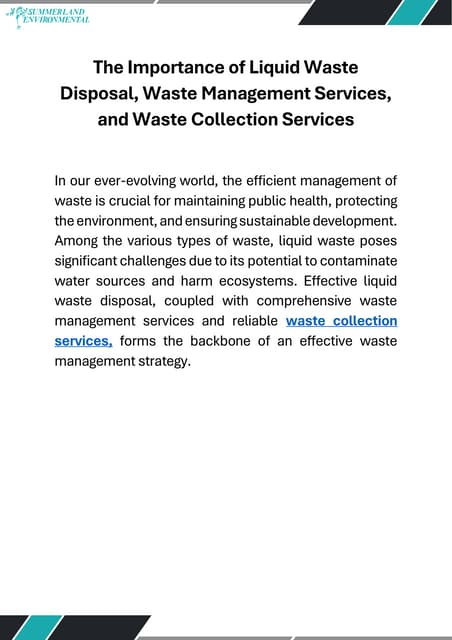Getting The Reclaim Waste To Work
Table of ContentsUnknown Facts About Reclaim WasteOur Reclaim Waste PDFsReclaim Waste for BeginnersHow Reclaim Waste can Save You Time, Stress, and Money.Unknown Facts About Reclaim Waste
Check out the types, occurrences, and forms of liquid waste. Domestic sewage waste refers to the waste and products from a residential septic system. This sort of waste is developed by humans in residences, colleges, and other buildings. This only consists of septic containers that have a drainpipe field. The correct administration and disposal of domestic sewer waste need liquid waste to be moved to a sewer treatment plant where the correct techniques and equipment are related to purify and dispose of waste.
Commercial waste often includes possible hazards, such as combustible products or a combination of liquid and solid waste items, and calls for an advanced and in-depth disposal procedure. The disposal of industrial waste typically involves the purification of waste before transport to ensure secure and appropriate disposal. Hazardous waste is developed from results and runoff of industrial processes and production.
This sort of waste can not use the exact same sewage administration transportation or processes as septic or commercial liquids. The hazardous waste monitoring procedure needs the assessment and screening of fluid waste prior to it goes through the disposal procedure (liquid waste removal). Drainage waste is the liquid waste that comes from runoff and excess stormwater in extremely booming locations or cities
Overflow waste can create contamination and flooding otherwise handled effectively. Find out more regarding sewage system cleansing and waste administration. Making certain proper waste administration can prevent catastrophes and decrease environmental harm. Both individuals in property setups and specialists in commercial or production sectors can take advantage of understanding the processes and guidelines of liquid waste management.
Some Of Reclaim Waste
Call PROS Services today to discover about our waste management and disposal services and the appropriate ways to care for the liquid waste you produce.
(https://www.slideshare.net/leonaube33101)This so-called 'wastewater' is not just an essential resource but, after treatment, will certainly be released to our land, waterways or the ocean. Utilized water from toilets, showers, baths, kitchen sinks, washings and industrial procedures is understood as wastewater.

water utilized to cool equipment or tidy plant and devices). Stormwater, a kind of wastewater, is overflow that streams from farming and city areas such as roofs, parks, gardens, roads, courses and rain gutters right into stormwater drains, after rainfall. Stormwater moves unattended straight to regional creeks or rivers, eventually getting to the ocean.
Some Ideas on Reclaim Waste You Should Know
In Queensland, the majority of wastewater is treated at sewer treatment plants. Wastewater is carried from residential or commercial websites with a system of sewage systems and pump stations, referred to as sewage reticulation, to a sewage treatment plant. Local federal governments build, preserve and operate most sewage treatment plants. Operators are licensed under the Environmental Management Act 1994 to discharge cured wastewater at an acceptable environmental standard right into rivers.
The Division of Natural Resources suggests neighborhood federal governments about handling, operating and preserving sewerage systems and therapy plants. In unsewered locations, local governments might need householders to set up individual or family sewage treatment systems to treat residential wastewater from commodes, cooking areas, shower rooms and laundries. The Department of Natural Resources authorizes the usage of house systems when they are proven to be effective.
In some brand-new communities, treatment of some stormwater to get rid of trash, sand and crushed rock has started utilizing gross pollutant catches. Wastewater treatment occurs in four phases: Removes strong matter.
Wastewater after that moves right into big containers where solids resolve and are eliminated as sludge. Oil and scum are skimmed from the surface. Makes use of little living microorganisms referred to as micro-organisms to break down and get rid of continuing to be liquified wastes and fine fragments. Micro-organisms and wastes are integrated in the sludge. Gets rid of nitrogen and phosphorus nutrients that could create algal blooms check this site out in our waterways and threaten aquatic life.
Get This Report on Reclaim Waste
Nutrient removal is not available at all sewer therapy plants since it needs pricey specialized tools. Clear liquid effluent produced after treatment might still have disease-causing micro-organisms - liquid waste disposal melbourne.

Most wastewater flows into the sewage system. Under the Act, regional federal governments carry out approvals and licences for environmentally appropriate tasks (Periods) involving wastewater launches that might have a neighborhood influence.
Some Of Reclaim Waste
Or else, examples are taken for research laboratory analysis. Usually many examinations are required to develop the levels of each of the different contaminants such as oils, hefty metals and pesticides in water. Surveillance supplies accurate details about water quality and can verify that permit problems are being fulfilled. The information obtained with monitoring supplies the basis for making water high quality decisions.